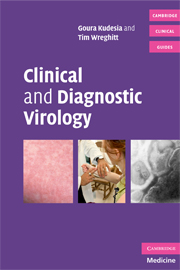Book contents
- Frontmatter
- Contents
- List of plates
- Preface
- Acknowledgements
- SECTION 1 INDIVIDUAL VIRUSES
- SECTION 2 OTHER RELATED AGENTS
- SECTION 3 CLINICAL SYNDROMES
- 32 Central nervous system viral infections
- 33 Viral eye infections
- 34 The common cold
- 35 Respiratory virus infections
- 36 Atypical pneumonia
- 37 Gastroenteritis viruses
- 38 Viral hepatitis
- Chapter 39 Genital tract and sexually transmitted infections (STIs)
- 40 Glandular fever-type illness
- 41 Viral rashes and skin infections
- 42 Infections in pregnancy, congenital and neonatal infections
- 43 Virus infections in immunocompromised patients
- 44 Viral malignancies
- 45 Travel-related infections
- SECTION 4 DIAGNOSTIC TECHNIQUES
- SECTION 5 PATIENT MANAGEMENT
- Index
- Plate section
45 - Travel-related infections
Published online by Cambridge University Press: 07 December 2009
- Frontmatter
- Contents
- List of plates
- Preface
- Acknowledgements
- SECTION 1 INDIVIDUAL VIRUSES
- SECTION 2 OTHER RELATED AGENTS
- SECTION 3 CLINICAL SYNDROMES
- 32 Central nervous system viral infections
- 33 Viral eye infections
- 34 The common cold
- 35 Respiratory virus infections
- 36 Atypical pneumonia
- 37 Gastroenteritis viruses
- 38 Viral hepatitis
- Chapter 39 Genital tract and sexually transmitted infections (STIs)
- 40 Glandular fever-type illness
- 41 Viral rashes and skin infections
- 42 Infections in pregnancy, congenital and neonatal infections
- 43 Virus infections in immunocompromised patients
- 44 Viral malignancies
- 45 Travel-related infections
- SECTION 4 DIAGNOSTIC TECHNIQUES
- SECTION 5 PATIENT MANAGEMENT
- Index
- Plate section
Summary
There has been an explosion in international travel during the past two decades. Travel in the past was the domain of the rich, but due to the availability of cheap air travel and ‘package holidays’ it has come within the grasp of most people in the developed world. People are travelling far, and to parts of the world that were previously inaccessible to them. The desire to visit far-flung ‘exotic’ locations is insatiable. With this travel comes the danger of being exposed to infections outside one's routine experience. There is also a tendency to throw caution to the wind, not to take the usual precautions and to expose one's self to risks. One of the aims of a holiday, after all, is to relax and try new experiences; it is not surprising therefore that many travellers become ill with infections while on holiday or bring them back. Below are some common (and some not so common) clinical illnesses due to infections that are seen in returning travellers in the UK (See Table 45.1). The reader should consult the individual virus chapters for details of individual infections.
Gastroenteritis
Diarrhoea is by far the most common complaint in travellers. Most of the infections are due to bacteria. Noroviruses are important viral pathogens, especially in those who indulge in eating raw shellfish such as oysters and prawns.
- Type
- Chapter
- Information
- Clinical and Diagnostic Virology , pp. 198 - 200Publisher: Cambridge University PressPrint publication year: 2009



